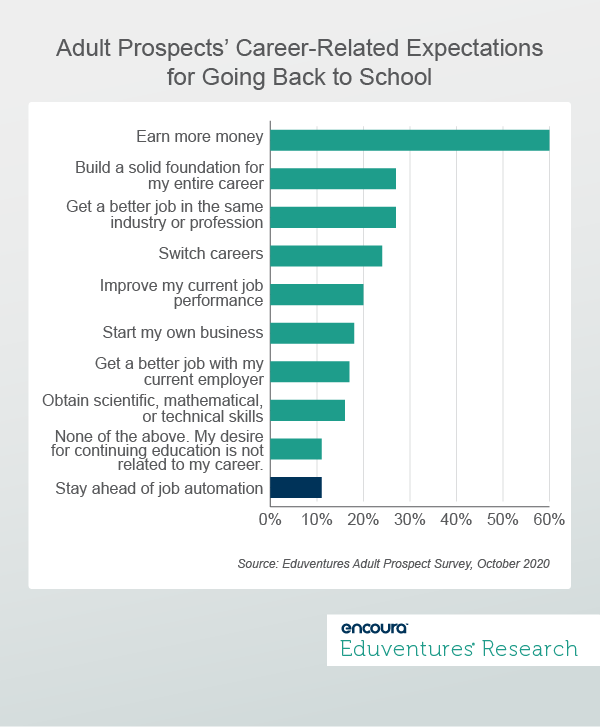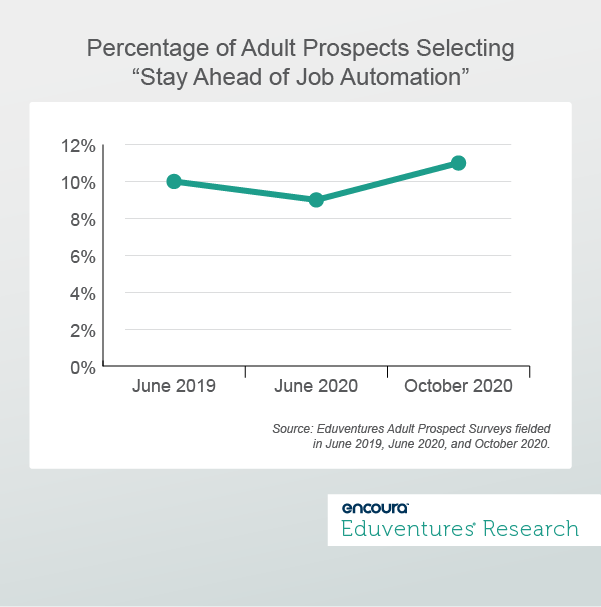For years, think tanks, academics, and journalists have sounded the alarm about the transformation of the modern workforce through job automation and artificial intelligence (AI). The question posed has always been “when” rather than “if.” When will new technologies change the compositions of jobs in the labor market, requiring large-scale reskilling, and leading to widespread job destruction?
This question is even more important as the COVD-19 pandemic continues to reshape many jobs. While institutional leaders work to future-proof academic program portfolios, many are also wondering whether they should be marketing and positioning their programs around the implications of automation.
Pump the Brakes
The prevailing narrative in recent years strongly signaled that the “when” of workforce automation was imminent. A 2018 World Economic Forum report predicted that machines would complete half of all work tasks by 2025. More recent think pieces have begun to explore the role of the coronavirus in accelerating the automation trend as dependence on global supply chains face greater scrutiny.
A new study by MIT’s task force on the Work of the Future, however, claims that widespread disruption by automation (through robotics, autonomous vehicles, and AI-enabled assistants) will take many more years to unfold. As the report finds, “the world has not been turned on its head by automation, nor has the labor market.”
Whether or not the effects of automation will be more immediate or delayed, the debate is sure to continue. To better understand it ourselves, we decided to add “stay ahead of job automation” as a response option in our Adult Prospect Survey™. With three iterations of the survey now providing this insight, Eduventures is beginning to have some answers about how adult prospects feel about it.
Figure 1 clearly shows that, at least when competing with other expectations and motivations, staying ahead of job automation is low on the list.

As the data shows, more tangible expectations such as earning more money, getting a better job, or even starting one’s own business rank higher in the minds of adult prospects considering returning to higher education. And, as Figure 2 shows below, the “stay ahead of job automation” option has received similar response rates over the last three survey iterations—about 10% across all three points in time.

Notably, the other responses are also remarkably consistent across this time period. Response options such as “earn more money,” “build a foundation for an entire career,” “get a better job in the same industry/profession,” “switch careers,” and “improve my current job performance” remain the top choices across all surveys, receiving a similar level of response each time.
Who are They?
While staying ahead of automation may not be top-of-mind for a majority of prospective adult learners—at least when compared to shorter-term career expectations—11% of our most recent sample did indicate that it was. So, just who are these adult prospects?
- They span age ranges. Interestingly, there are no major age differences between those adult prospects selecting “stay ahead of job automation” and all others, suggesting that older adults are not thinking about this topic more than their younger peers. Thirty-one percent in each segment are over the age of 45, and 29% are between the ages of 25-34.
- They have pursued higher education at a higher rate. The credential mix between those prospects selecting “stay ahead of job automation” and those who did not is similar. But while only 12% of those selecting “stay ahead of job automation” said they have never enrolled in a college or university, this number rises to 16% for all other adult prospects.
- They indicate higher interest in computer science and aligned programs. While 17% of adult prospects selecting “stay ahead of job automation” indicated interest in computer sciences and support services (including data analytics and cybersecurity), 10% of all other adult prospects reported the same— the most significant gap across intended fields of study.
- They report a higher likelihood of enrolling in alternative education programs. A higher proportion of adult prospects selecting “stay ahead of job automation” (19%) report greater interest in an alternative education program than all other prospective adults (10%). This includes options such as MOOCs and coding bootcamps.
- They want access to career services. Twenty-six percent of adult prospects selecting “stay ahead of job automation” desire access to career services versus 20% of all other adult prospects.
- They are more interested in returning to school due to COVID-19. Fifty-six percent of adult prospects selecting “stay ahead of job automation” reported greater interest in returning to college or university as a result of COVID-19, while only 45% of all other adult prospects reported more interest—perhaps a sign that some indeed see COVID-19’s impact on the labor market as an accelerant for automation in the workplace.
The Bottom Line
What does this mean for schools? In many ways, our findings might challenge some assumptions. For instance, it is not as simple as saying older and less educated adults might respond better to the theme of automation. But at the same time, some assumptions might be affirmed. Prospects worried about automation signaled a preference for computer science-aligned programming—a field where many jobs are less at risk.
Finally, the ongoing pandemic may be driving those wary of automation to consider returning to higher education more so than usual. That means it’s more important than ever to understand the nuances around this prospect pool and to get the messaging right.
It’s possible that the threat of automation may simmer on the minds of prospective adult learners more broadly, but our data shows that, at least when competing with other expectations for school, it is not a top issue. Since our research reveals that such language may only resonate with a small segment of adults, targeting degree programs aligned to computer and information sciences, data analytics, and similar programs—as opposed to wide-scale, general marketing campaigns—is advisable.
Additionally, programs that adopt the theme of automation should draw clear lines to career services access, and, if the program confers a traditional credential, articulate why a student would benefit from such a program (as opposed to MOOCs and bootcamps that have proliferated in recent years).
These findings could also reinforce that most prospects simply want to feel hopeful about going back to school. Some of the response options like “earn more money” or “get a better job” certainly convey a more positive tone compared to the threat of automation. When choosing between answers that are hopeful vs. not, prospects may gravitate to the hopeful—which carries lessons for marketing, too.
Interested in learning more about adult prospects? Contact your Client Research Analyst today to dig into the Adult Prospect Survey data further.
Never Miss Your Wake-Up Call
Learn more about our team of expert research analysts here.
Eduventures Client Research Analyst at ACT | NRCCUA
Contact
This recruitment cycle challenged the creativity of enrollment teams as they were forced to recreate the entire enrollment experience online. The challenge for this spring will be getting proximate to admitted students by replicating new-found practices to increase yield through the summer’s extended enrollment cycle.
By participating in the Eduventures Admitted Student Research, your office will gain actionable insights on:
- Nationwide benchmarks for yield outcomes
- Changes in the decision-making behaviors of incoming freshmen that impact recruiting
- Gaps between how your institution was perceived and your actual institution identity
- Regional and national competitive shifts in the wake of the post-COVID-19 environment
- Competitiveness of your updated financial aid model

